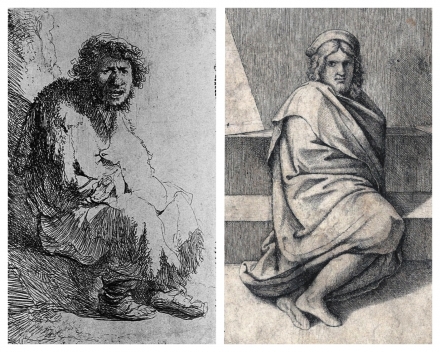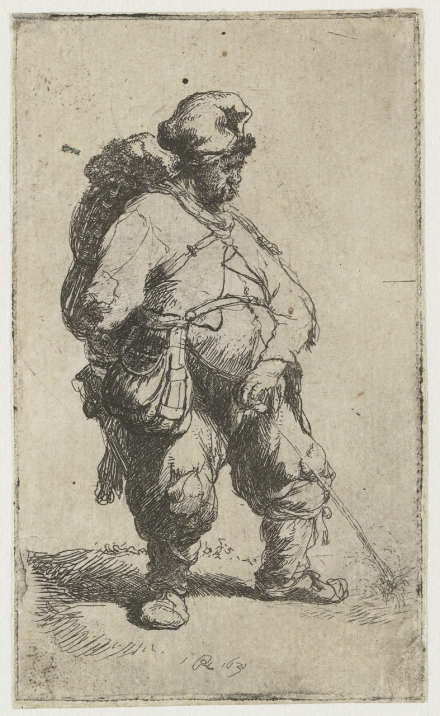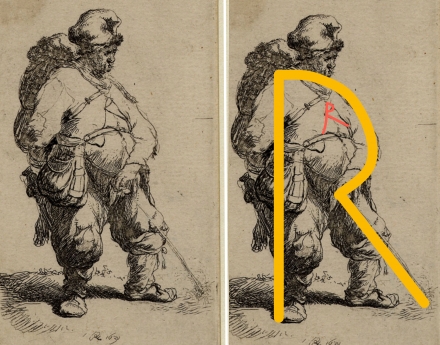Rembrandt’s Man Making Water (1631) and Woman Making Water and Defecating (1631)
Water has life-sustaining powers. Urine too has been praised by Pliny and others as therapeutic since antiquity. In the 1970’s an Indian Prime Minister recommended a glass a day. In medieval Europe and the Renaissance piss and life-producing semen were considered identical. We should be careful then when people in art pee; the scene may not be a slice of life after all because urine’s generative power is a perfect metaphor for an artist’s, at least in etchings as we will see.
Take Rembrandt’s etched image of a peasant peeing into the corner of the sheet. It’s titillating but art must do more than amuse and you can be certain that a scene signed by Rembrandt, or any great artist, does not just imitate life. If it did, it would not be signed. There are two notable etchings of figures urinating in Rembrandt's oeuvre, this one and another of a woman. In surveys of Rembrandt's prints modern prudishness usually relegates them to a footnote or avoids them entirely.1 Yet we at EPPH, aware of art’s self-referential essence, pay attention as they afford an excellent lesson in how ordinary art lovers can interpret art on their own.
Specialists have asked why 17th-century Dutch artists created realistic scenes of life like this when a defining trait of Dutch culture was distrust of sight.2 Yet those by true artists are illusions. They too warn: don’t trust your sight. We are not what you think.
Click next thumbnail to continue

L: Rembrandt, Beggar Seated on a Bank (1630) Etching
R: Raimondi, Portrait of Raphael (early 16th century)
Click image to enlarge.
Indeed separate posts have already shown how Rembrandt’s beggars, most composed in his twenties', are artists themselves. Beggar Seated on a Bank (left) features Rembrandt's face. Yet the figure is also based on an etched portrait of Raphael by Marcantonio Raimondi (right).Thus it represents Rembrandt as Raphael looking out over his shoulder. The borrowed form borrows meaning uniting the two artists in their shared endeavor.
Click next thumbnail to continue
Once known we can more easily recognize that this later image (left) is formed, like Raphael’s Sistine Madonna and other figures by both R-named painters, into a large R with a smaller R, angled like that in his signature, on his torso (right). Generally invisible both R’s become a badge-of-honor and a symbol of the self.
Click next thumbnail to continue
And while figures and animals do pee in oil paintings as well, many are etched which begs the question why. The etching process includes an acid bath to create the grooves which appear as lines. The acid eats into the copperplate. Urine is similarly “strong” water which is why the French call etchings eau-forte, the Italians aquaforte and the Germans scheidewasser which can literally be read as “vagina water”.3 Thus in the end we come to recognize that Rembrandt’s R-shaped peasant and the woman here are peeing onto their plate to etch their lines, a print still in the process of being made. Like so many scenes in art, it is philosophical and depicts the only moment that exists, the ever-present "now".
For a comparable etching by Rembrandt of another subject see The Hog (1643).
More Works by Rembrandt
How realism and the use of models fools the eyes. Art, one must remember, is never 'real' and never 'photographic'.

Rembrandt’s A Bearded Man in a Cap (1657)
Notes:
1. Ger Luijten in Rembrandt the Printmaker (London: British Museum Press) 2000, p. 106
2. Mariet Westermann, “After Iconography and Iconoclasm: Current Research in Netherlandish Art, 1566-1700”, Art Bulletin 84, June 2002, p. 360
3. The etymology of the German scheidewasser (etching) is usually explained as the combination of scheiden (separate) and wasser (water) without providing any reason. I cannot think of any. The etymologists probably do not suggest the even closer connection to scheide (vagina) and wasser (water) as the origin of the term because the significance of vagina-water might to them sound as meaningless as separate-water while being vulgar too. The Dutch word etsen like the English etching stems from the Proto-Indo-European or Sanskrit sound et signifying to eat because the acid eats into the plate. In all the non-German languages cited the word refers to the acid in the etching process; the German is likely to as well.
Original Publication Date on EPPH: 16 Jul 2022. © Simon Abrahams. Articles on this site are the copyright of Simon Abrahams. To use copyrighted material in print or other media for purposes beyond 'fair use', you must obtain permission from the copyright owner. Websites may link to this page without permission (please do) but may not reproduce the material on their own site without crediting Simon Abrahams and EPPH.





